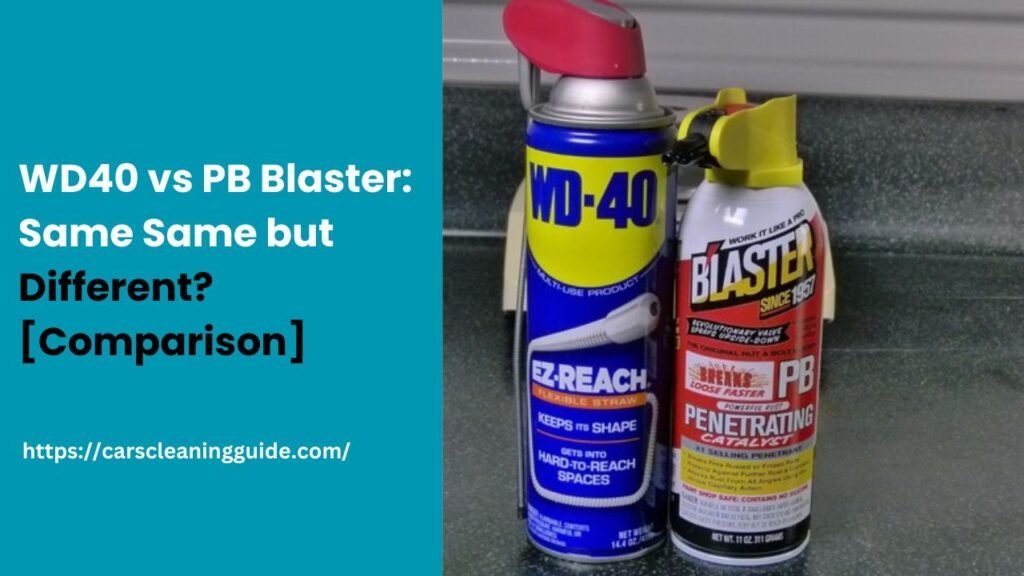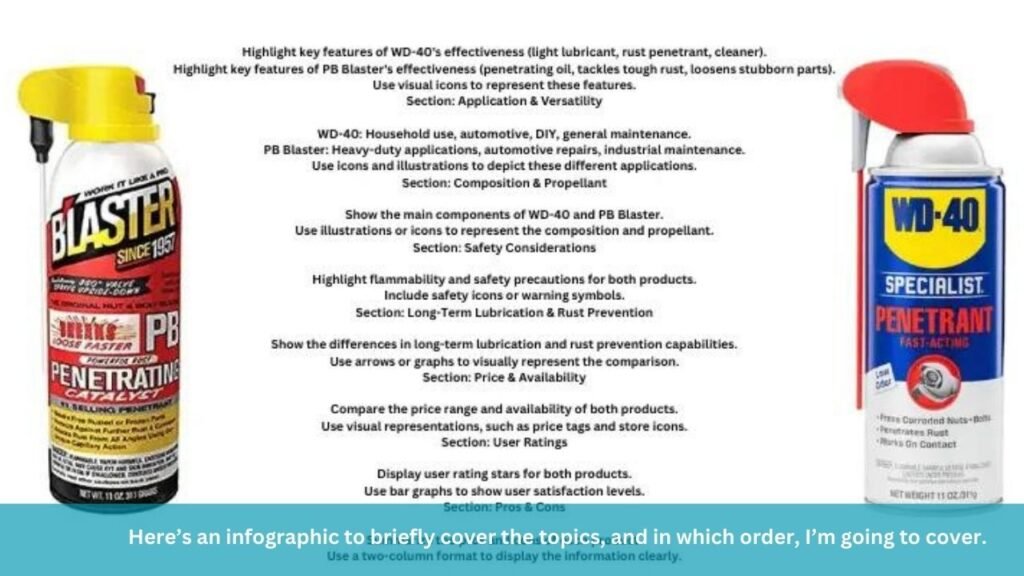
Whenever you talk about automotive lubricants and rust removers, two names often rule the roost: WD-40 and PB Blaster.
Both have achieved hero status in the grooming world, each with their own loyal following, but they are really the same, or do they each offer a combination of performance & performance opportunities?
Welcome to the ultimate guide between WD40 and PB Blaster where we peel back the brand’s reputation and take a closer look at their capabilities.
The purpose of this comparison is to examine their strengths, weaknesses, and ideal usage scenarios, giving you the insights you need to make an informed decision. So strap in and get ready for a detailed look at these two industry titans to find out if it’s a case of the same but different or if one really outshines the other.
Here is a pictorial overview to briefly cover the topics in which I am going to cover them.

Introducing WD-40.
WD-40 is a name that resonates with many. It is a popular product that has been around since the early 1950s. WD in WD-40 stands for water displacement which refers to one of its primary functions. It is a petroleum-based lubricant containing a mixture of anti-corrosion agents and various lubricants.
WD-40 Pros & Cons Table
| Pros | Cons |
|---|---|
| Versatile: WD-40 is Suitable for various tasks including lubrication, rust prevention, and light cleaning. | Temporary lubrication: Frequent re-application may be required for lubrication after a while. |
| Affordable: Budget-friendly and widely available in stores and online retailers. | Limited rust prevention: Primary coating provides protection but is not ideal for long-term corrosion prevention. |
| Widely Used: Popular and trusted by many users for its effectiveness in home application. | Flammable: It is flammable and should be used with caution around open fires or sparks. |
| Pleasant smell: Some users find the distinctive smell of WD-40 pleasant. | Not heavy duty: Not suitable for tackling tough rust and heavy stuck parts. |
| Multipurpose: Various DIY plans can be used for automotive maintenance and general tasks. | May not be ideal for professionals and heavy-duty industrial use. |
Uses and Benefits of WD-40
WD-40 is known for its multi-purpose utility. This durability has made it a must-have in every home, garage, or workshop. Here are some ways drivers and maintenance professionals use WD-40.
- Rust removal and cleaning
- Lubrication of door handles and seat belt mechanisms
- Removal of bird droppings
- Moisture displacement from components
- Removal of carbon deposits
- Removal of engine grime and grease
- Silently screeching brakes
- Unfrozen rusted parts
- Removal of scratches and marks from body work
WD-40’s water-displacing formula is gentle yet strong, cutting through dirt without damaging it. It’s no wonder it’s trusted in countless homes and garages around the world.
WD-40 Drawbacks
Despite its widespread use, WD-40 has some shortcomings, for example, it struggles to free severely rusted bolts, and it can produce fumes when sprayed on police trains or polycarbonate.
Introducing the PB Blaster
A strong competitor to WD-40 is PB Blaster. The PB Blaster was introduced in 1957. This fast oil has carved a niche for itself, especially in the industrial, marine, and plumbing sectors. PB Blaster’s water-based formula contains anti-corrosion chemicals and a non-evaporating lubricant.
PB Blaster Advantages & Disadvantages Table
| Pros | Cons |
|---|---|
| Exceptional penetration: Highly effective in breaking rust and stuck parts. | Strong odor: PB Blaster has a distinct strong odor that can be overpowering in enclosed spaces. |
| Heavy Duty: Designed for rust removal and challenging industrial applications. | Highly Flammable: Use with extreme caution due to the presence of flames, sparks, or heat. |
| Long-Lasting Lubricants: Provides better and more durable lubrication than WD-40. | More expensive: The heavy-duty qualities generally feel expensive. |
| Professional grade: Ideal for Automotive repair, industrial maintenance, and heavy-duty applications. | Not versatile: It’s great for primarily heavy-duty tasks, but it may not be as efficient for light home use. |
| Positive user Ratings: It is highly regarded for its effectiveness and efficiency. | Limited rust prevention: Longer-term rust protection is not subject to solution. |
Uses & Benefits of PB Blaster
- PB Blaster is highly appreciated for its ability to deal with severe cases of rust and corrosion. It also provides clean lubrication and protection against future rusting of metal objects Here are some of the ways in which PB Blaster is commonly used.
- Rust prevention and removal
- Protection of metal objects against moisture
- Restoration of metal object shine and luster
- Remove stubborn dirt and corrosion
The PB Blaster’s effectiveness in accessing small spaces and corners makes it a go-to product for many users. Its post-application function also sets it apart as it plays an important role in protecting components from water and future corrosion.
Disadvantages of PB Blaster
Despite his immense effect, the use of PB blaster comes with a few warnings. The application process produces a lot of smoke that may be a challenge for some users. Therefore it is advisable to wear protective clothing during application.
WD40 vs PB Blaster A Detailed Comparison
The choice between WD40 & PB plaster is often in accordance with consumers’ specific requirements. To help you make a better decision, let’s compare these products in detail. But first, see this table for a high-level review:
| Feature | WD-40 | PB Blaster |
|---|---|---|
| Overview | WD40 is a versatile domestic lubricant and cleaner. | PB Blaster is a sharp oil and lubricant spray. |
| Effectiveness | Effective as a mild lubricant rust remover and cleaner for small jobs and mild corrosion. | Exceptionally free as an abrasive oil, ideal for heavy-duty and challenging rust removal. |
| Application | Lubricant, Rust prevention for moisture, migration & light cleaning. | Penetrates rust, Loosens stuck bolts, nuts, & other stubborn parts. |
| Versatility | versatile is used in Household, Automotive, DIY projects, and general maintenance. | Primarily intended for heavy-duty applications, automotive repair, industrial maintenance and professional use. |
| Composition | The mixture of solvent, mineral oil and corrosion inhibitors. | Formulated with a blend of solvent oils & proprietary additives. |
| Propellant | A propellant is used for CO2. | The propellant is used for propane and butane. |
| Odor | WD40 has a characteristic odor that some may find pleasant. | PB Blaster has a distinct strong smell that can be overpowering in enclosed spaces. |
| Flammability | WD-40 is a flammable substance and always take special care when using it, never using it near open flames or sparks. | PB Blaster is a highly flammable substance and should be used with extreme caution in the presence of large sparks or heat sources. |
| Long-Term Lubrication | WD-40 provides temporary lubrication but may require repeated applications. | PB Blaster offers long-lasting lubrication that reduces the need for frequent reapplication and also cuts costs. |
| Rust Prevention | Provides basic rust protection but is not suitable for long-term corrosion prevention. | It’s not designed as a long-term rust prevention solution. |
| Price | Generally affordable and budget-friendly. | Often slightly more expensive because of its heavy-duty capabilities. |
| User Ratings | Most Popular and widely used, with generally positive user reviews. | It’s highly regarded for its effectiveness, especially in tackling tough corrosion & rust. Users praise its performance. |
| Availability | Available at all hardware stores, supermarkets, and online retailers. | Widely available in automotive supply stores, online, and hardware stores. |
Versatility
WD-40 reigns supreme in terms of versatility. Its water displacement is useful for hundreds of jobs, from rust removal to grime cutting. PB Blaster, however, is designed primarily for heavy-duty rust and corrosion removal.
Efficiency in Rust Removal
When it comes to rust removal, PB Blaster takes the crown for its fine performance. Its high-quality oil-based formula allows it to cover all small gaps, nooks and crannies. which simultaneously removes rust and dirt while WD-40 also has anti-corrosion properties. PB Blaster is generally considered a stronger product due to its immense properties.
Raw power
When it comes to power, PB Blaster eliminates WD-40. Its high-quality dirt removal properties that allow it to remove crime dirt and other unwanted agriculture with greater accuracy and precision. Although WD-40 is a stronger agent, PB Blaster delivers more with less effort.
Performance
PB Plaster is a high-performance oil that glides easily into various nooks and crannies, giving them a spotless clean. Its accessibility makes it highly effective in its tasks while WD-40 is also a reliable product, its efficiency is very low compared to PB blaster.
Safety facts
In terms of safety, WD-40 is a safer option as its water-based formula does not contain the potentially harmful chemicals found in PB blasters. Therefore, it is important to read and follow the instructions on the box carefully and keep them out of the reach and sight of children.
Price
WD-40 is a cheaper option in terms of price. However, the high price tag of PB Blaster is justified due to its superior rust removal properties and strength.
The Verdict: WD40 vs PB Blaster
Winning the WD40 vs. PB Blaster battle depends largely on your specific needs. If you are looking for a versatile product that can handle a wide range of jobs, WD-40 is the best choice for you, but for heavy-duty deburring and corrosion removal, there is no better choice than PB Blaster.
Despite their differences, both products are extremely effective at cleaning stubborn dirt, removing rust, and preventing future rust. Whether you opt for WD40 or PB Blaster, you are sure to be extremely satisfied and happy with the results.
Frequently Asked Questions & Related Questions
Which materials are more effective and better for removing rust?
PB Blaster is highly effective for rust removal due to its exceptional penetrating properties. It can easily break rusted and stuck parts making it the preferred choice for heavy-duty applications.
Is it a safe practice to use WD40 around open fires or sparks?
WD-40 is a flammable substance and requires extreme caution when used around open flames or sparks. It is advised to keep it away from possible sources of ignition and follow the safety instructions on the product label very carefully.
Can I use PB Blaster for household chores and general maintenance?
Although PB Blaster is highly effective for heavy-duty applications, it may not be the best choice for general household work due to its strong odor and high cost.
Does WD40 provide long-lasting lubrication?
WD-40 provides a temporary lubricant that makes it ideal for short-term tasks and applications. Consider using a PB blaster for long-lasting lubrication, especially for parts that require extended protection and reduced reuse.
Are there any special safety precautions when using PB Blaster?
Yes, PB Blaster is a highly flammable substance and users need to take extreme safety precautions when using it around open sparks or heat sources. Adequate ventilation in enclosed spaces is essential due to its pungent odor Strictly follow the safety instructions provided on the product label.
Conclusion
The WD-40 vs PB blaster debate boils down to specific use cases. Both products offer a number of advantages that make them a staple in homes, garages, and workshops, whether you’re fighting rust by loosening stuck parts. Both WD-40 and PB Plaster offer reliable solutions for lubrication problems. Choosing the better between the two will ultimately depend on your specific needs and preferences.
